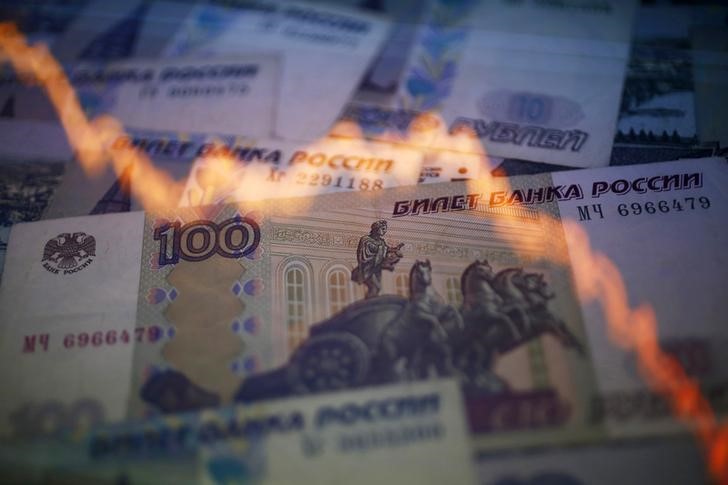 © Reuters. Ruble Nears Two-Month High, Sparks Doubt Over ‘Synthetic’ Rally
© Reuters. Ruble Nears Two-Month High, Sparks Doubt Over ‘Synthetic’ Rally
(Bloomberg) -- The ruble rallied for a third day to approach the highest in more than two months, evoking skepticism from currency strategists who say the market is broken because of capital controls, forced dollar sales and ultra-thin volumes.
Russia’s currency jumped as much as 7.3% on Thursday, sealing its rebound from a collapse that followed the nation’s invasion of Ukraine and sanctions that isolated it from the global financial system. A key driver of the latest gains is the continued demand for Russia’s oil and gas in Europe and elsewhere, handing the country almost $1 billion a day in revenue.
Mocked as ‘Rubble’ by Biden, Russia’s Ruble Comes Roaring Back
Strategists say the ruble’s rally isn’t credible: The exchange rate is no longer free-floating and the currency would be at a very different level if barriers were removed. With Russia tottering on the brink of a debt default and the economy shrinking, the ruble no longer reflects the country’s fundamentals, they say.
“It’s a completely artificial level and so very little credence should be given to it,” said Cristian Maggio, the head of portfolio strategy at Toronto Dominion Bank in London. “Almost no one can trade the ruble and those who really do, they trade at very different levels than what the screens report. From a market and macroeconomic point of view, it makes no sense.”
The exaggerated moves in the ruble coincide with a plunge in trading volumes. The 20-day average of daily volumes in the currency has fallen to the lowest since 2012 as foreign investors cut exposure to Russian assets.
Ruble volatility is surging. Realized 30-day swings have jumped to 79%, a record high that beats the 74% reached in the aftermath of the 2014 ruble crisis. While one-month implied volatility has come off its peak, it still remains high at 55%, compared with less than 12% before the invasion.
Given the thin participation, the ruble’s moves are dictated by the government’s tough capital controls. Those include a ban on foreigners selling Russian assets as well as mandated hard-currency sales by exporters.
Outflows Blocked
“It’s important to stress that it’s not a properly functioning market,” said Piotr Matys, a senior currency analyst at InTouch Capital Markets Ltd. in London. “The ruble is not a free-trading currency after Russia imposed various restrictions that essentially prevent capital outflows.”
Adding to the complexity, Putin has demanded that foreign buyers pay in rubles for Russia’s natural gas. While European officials rejected the plan when it was first announced, a French official said March 31 that the new mechanism won’t change payments as mandated in supply deals, which will continue as before.
All the moving parts mean price discovery is close to impossible.
“My focus has been limited on ruble lately purely because it is a synthetic market,” said Simon Harvey, the head of currency analysis at Monex Europe. “Once the depth comes back, pricing will look wildly different to where it is currently trading at, unless there is severe intervention or continued capital restrictions.”
©2022 Bloomberg L.P.

